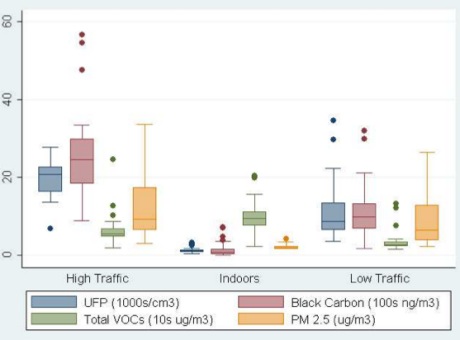[Via Environmental Health News]
In what researchers call the first study ever to examine the relationship between traffic-related air pollution exposures and cardiac health among people who ride bikes, a study published last month found that cycling near heavy traffic “may have a significant impact” on heart health.
The research, Traffic-Related Air Pollution and Acute Changes in Heart Rate Variability and Respiratory Function in Urban Cyclists, was done in Ottawa by Canadian researchers and published in the journal Environmental Health Perspectives.

Researchers monitored 42 healthy adults and compared their vital signs after cycling for one hour on high and low-traffic routes as well as indoors. The results showed irregularities in cardiac function, also known as heart rate variability (HRV), a condition that has been shown to be a predictor of mortality following heart attacks.
“Our findings suggest,” the researchers concluded, “that short-term exposure to traffic may have a significant impact on cardiac autonomic function in healthy adults.”
While they found a heightened risk to heart health when cycling near tailpipes, researchers noted that, “the clinical implications of this relationship are unclear as the health benefits of cycling might outweigh any potential negative impact.”
Interestingly, the study authors recommend that people choose bikeways that are away from high-traffic areas:
“… our findings suggest that when possible it may be prudent to select cycling routes that reduce exposure to traffic and/or to avoid cycling outdoors or exercise indoors on days with elevated air pollution levels. In addition, the planning of new cycling routes/bicycle paths in urban areas should aim to minimize time spent in high-traffic areas in order to reduce exposures of recreational riders (e.g. elderly) who may be more susceptible to the acute cardiovascular health effects of traffic-related air pollution.”
That portion of the findings reminds me of a recent study at the Department of Environmental Science at Portland State University. As we reported last fall, that study concluded that a bikeway separated from motor vehicle traffic by even a few feet may be, “more protective for cyclists than a traditional bicycle lane in terms of lowering exposure concentrations of ultrafine particles.”
The Canadian study should also give added momentum to planners who are pushing low-traffic bikeways like Portland’s Neighborhood Greenways as alternatives to biking on main streets.
For more on the Canadian study, read coverage published today by Environmental Health News or visit the Environmental Health Perspectives website to download the full PDF of the results.


